Bond Modelling for the Assessment of Transmission Length in Prestressed-Concrete Members
Abstract
:1. Introduction
2. Roles of the Major Parameters Affecting the Transmission Length
3. Analytical Modelling of the Transmission Length
3.1. General Calculation Procedure
3.2. Elastic Analysis Based on the Thick-walled Cylinders Theory
3.3. Anisotropic Analysis for Cracked Concrete
4. Model Calibration and Results
4.1. Global Behaviour: Transmission Length Assessment
4.2. Local Behaviour: Radial Cracking and Bond Stress Development
5. Conclusions
Author Contributions
Funding
Acknowledgments
Conflicts of Interest
Statement of Data Availability
Nomenclature
| Ac | Cross-sectional area of concrete |
| Asp | Cross-sectional area of prestressing tendon |
| b | Width of the concrete section |
| c | Concrete cover thickness |
| , | Constants of integration for the solution of u |
| Ec | Elastic modulus of concrete |
| Eps | Elastic modulus of prestressing steel |
| e | Vertical eccentricity of the considered tendon with respect to the centre of gravity of the concrete section |
| h | Height of the concrete section |
| Jx | Moment of inertia of the concrete section |
| Lt | Transmission length of the prestressing tendon |
| Lt, experimental | Experimental value of the transmission length |
| Lt, theoretical | Theoretical value of the transmission length |
| lbp | Basic anchorage length according to fib MC2010 |
| P | Initial prestressing-force in the tendon |
| r | Radial distance from the tendon centroid |
| rjack | Radius of the tendon after release |
| rps | Radius of the unstressed tendon |
| rtip | Distance from the tendon centroid to the crack tip |
| u | Radial displacement |
| uc | Radial displacement of the concrete |
| ups | Radial displacement of the tendon outer surface |
| y | Vertical distance from the centre of gravity of the concrete section |
| z | Length of the single finite element in which the prestressing tendon is subdivided |
| z | Longitudinal distance from the free-end of the PC member |
| αp1 | Coefficient which takes into account the prestress release method, according to fib MC2010 |
| αp2 | Coefficient which takes into account the action effect to be verified, according to fib MC2010 |
| αp3 | Coefficient which takes into account the influence of bond situation, according to fib MC2010 |
| αrel | Coefficient which takes into account the prestress release method, according to the findings proposed by the authors |
| Concrete strain (assumed as 0.0003) corresponding to concrete tensile stress equal to 0.15 , according to Han’s softening model | |
| Cracking strain of concrete | |
| Concrete strain in the radial direction | |
| Concrete strain in the circumferential direction | |
| Concrete axial strain at the level of the tendon centroid | |
| Ultimate concrete strain (assumed as 0.002) corresponding to concrete tensile stress equal to zero, according to Han’s softening model | |
| ηp1 | Coefficient which takes into account the type of tendon, according to fib MC2010 |
| ηp2 | Coefficient which takes into account the position of the tendon, according to fib MC2010 |
| Overall friction coefficient between the tendon and the surrounding concrete, combining actual frictional and mechanical bond | |
| Poisson’s ratio of the concrete | |
| Poisson’s ratio of the prestressing steel | |
| Prestress transfer bond at the interface tendon-concrete | |
| Concrete radial stress | |
| Concrete circumferential stress | |
| Concrete axial stress | |
| Tensile strength of concrete | |
| Design tensile strength of the prestressing steel | |
| Tendon radial stress | |
| (rjack) | Radial compressive stress at the interface between steel and concrete, arising from the Hoyer effect |
| Increment in tendon stress resulting from the development of bond stress along the finite element | |
| Tendon stress at the considered point along the length of the member | |
| Jacking stress of the tendon at prestressing-force release | |
| φ | Nominal tendon diameter |
References
- fib Model Code 2010. fib Model Code for Concrete Structures; International Federation for Structural Concrete (fib): Lausanne, Switzerland, 2013. [Google Scholar]
- ACI Committee 318. Building Code Requirements for Structural Concrete (ACI 318-14) and Commentary (ACI 318R-14); American Concrete Institute: Farmington Hills, MI, USA, 2014. [Google Scholar]
- Janney, J.R. Nature of bond in pretensioned prestressed concrete. ACI J. 1954, 50, 717–736. [Google Scholar]
- Hanson, N.W.; Kaar, P.H. Flexural bond of pretensioned prestressed beams. ACI J. 1959, 55, 783–802. [Google Scholar]
- Metelli, G.; Plizzari, G.A. Influence of the relative rib area on bond behaviour. Mag. Concr. Res. 2014, 66, 277–294. [Google Scholar] [CrossRef] [Green Version]
- Pellegrino, C.; Zanini, M.A.; Faleschini, F.; Corain, L. Predicting bond formulations for prestressed concrete elements. Eng. Struct. 2015, 97, 105–117. [Google Scholar] [CrossRef]
- Mohandoss, P.; Pillai, R.G.; Sengupta, A.K. Transmission length of pretensioned concrete systems - comparison of codes and test data. Mag. Concr. Res. 2018, 71, 1–13. [Google Scholar] [CrossRef]
- Abdelatif, A.O.; Owen, J.S.; Hussein, M.F. Modelling the prestress transfer in pre-tensioned concrete elements. Finite Elem. Anal. Des. 2015, 94, 47–63. [Google Scholar] [CrossRef]
- Ramirez-Garcia, A.T.; Dang, C.N.; Hale, W.M.; Martí-Vargas, J.R. A higher-order equation for modeling strand bond in pretensioned concrete beams. Eng. Struct. 2017, 131, 345–361. [Google Scholar] [CrossRef]
- Eurocode 2. Design of Concrete Structures-Part 1-1: General Rules and Rules for Buildings; Comitè Europèen de Normalisation: Brussels, Belgium, 2004. [Google Scholar]
- Oh, B.H.; Kim, E.S. Realistic evaluation of transfer lengths in pretensioned prestressed concrete members. ACI Struct. J. 2000, 97, 821–830. [Google Scholar]
- Dang, C.N.; Hale, W.M.; Martì-Vargas, J.R. Quantification of bond performance of 18-mm prestressing steel. Constr. Build. Mater. 2018, 159, 451–462. [Google Scholar] [CrossRef]
- Zia, P.; Mostafa, T. Development length of prestressing strands. PCI J. 1977, 22, 54–65. [Google Scholar]
- Martí-Vargas, J.R.; Serna-Ros, P.; Navarro-Gregori, J.; Bonet, J.L. Effects of concrete composition on transmission length of prestressing strands. Constr. Build. Mater. 2012, 27, 350–356. [Google Scholar] [CrossRef]
- Mitchell, D.; Cook, W.D.; Kahn, A.A.; Tham, T. Influence of High-Strength concrete on transfer and development length of pretensioning strand. PCI J. 1993, 38, 52–66. [Google Scholar] [CrossRef]
- Oh, B.H.; Kim, E.S.; Choi, Y.C. Theoretical analysis of transfer lengths in pretensioned prestressed concrete members. J. Eng. Mech. 2006, 132, 1057–1066. [Google Scholar]
- Base, G.D. An Investigation of Transmission Length in Pretensioned Concrete. In Proceedings of the Third Congress of FIP-Session III, Brussels, Belgium, 1958; pp. 603–623. [Google Scholar]
- Holmberg, A.; Lindgren, S. Anchorage and Prestress Transmission; Document D1; National Swedish Institute for Building Research: Stockholm, Sweden, 1970. [Google Scholar]
- Kaar, P.H.; Hanson, N.W. Bond fatigue tests of beams simulating pretensioned concrete crossties. J. Prestress. Concr. Inst. 1975, 20, 65–80. [Google Scholar] [CrossRef]
- Cousins, T.E.; Johnston, D.W.; Zia, P. Transfer and development length of epoxy-coated and uncoated prestressing strand. PCI J. 1990, 35, 92–103. [Google Scholar] [CrossRef]
- Pellegrino, C.; Faleschini, F.; Fabris, N.; Zanini, M.A. Bond of Prestressing Tendons; Internal report, Submitted to: Fib Bulletin on “Advances on Bond in Concrete”; University of Padova: Padua, Italy, 2018. [Google Scholar]
- Deatherage, J.H.; Burdette, E.G.; Chew, C.K. Development length and lateral spacing requirements of prestressing strand for prestress concrete bridge girders. PCI J. 1994, 39, 70–83. [Google Scholar] [CrossRef]
- Barnes, R.W.; Groove, J.W.; Burns, N.H. Experimental assessment of factors affecting transfer length. ACI Struct. J. 2003, 100, 740–748. [Google Scholar]
- Russell, B.W.; Burns, N.H. Measured transfer lengths of 0.5 and 0.6 in. Strands in pretensioned concrete. J. Struct. Eng. 1996, 123, 44–65. [Google Scholar] [CrossRef]
- Tepfers, R. Cracking of concrete cover along anchored deformed reinforcing bars. Mag. Concr. Res. 1979, 31, 3–12. [Google Scholar] [CrossRef]
- Han, S.J.; Lee, D.H.; Cho, S.H.; Ka, S.B.; Kim, K.S. Estimation of transfer lengths in precast pretensioned concrete members based on a modified thick-walled cylinder model. Struct. Concr. 2016, 17, 52–62. [Google Scholar] [CrossRef]
- Han, S.J.; Lee, D.H.; Kim, K.S.; Seo, S.Y.; Moon, J.; Monteiro, P.J. Degradation of flexural strength in reinforced concrete members caused by steel corrosion. Constr. Build. Mater. 2014, 54, 572–583. [Google Scholar] [CrossRef]
- Russell, B.W.; Burns, N.H. Measurement of transfer lengths on pretensioned concrete elements. PCI J. 1997, 41, 541–549. [Google Scholar] [CrossRef]
- Martì-Vargas, J.R.; Arbeláez, C.A.; Serna-Ros, P.; Castro-Bugallo, C. Reliability of transfer length estimation from strand end slip. ACI Struct. J. 2007, 104, 487–494. [Google Scholar]
- Dang, C.N.; Hale, W.M.; Martì-Vargas, J.R. Assessment of transmission length of prestressing strands according to fib Model Code 2010. Eng. Struct. 2017, 147, 425–433. [Google Scholar] [CrossRef]
- Martins, J.A.C.; Oden, J.T. Interface models, variational principles and numerical solutions for dynamic friction problems. In Mechanics of Material Interfaces, Proceedings of ASCE/ASME Mechanics Conference, Albuquerque, NM, USA, 23–26 June 1985; Elsevier: Amsterdam, The Netherlands, 1985. [Google Scholar]
- Olofsson, U.; Holmgren, M. Friction Measurement at Low Sliding Speed Using a Servo-Hydraulic Tension-Torsion Machine; Report SP AR 1992:51; Swedish National Testing Institute-Building Structures Section: Stockholm, Sweden, 1992. [Google Scholar]
- den Uijl, J.A. Bond modelling of prestressing strand. ACI Spec. Publ. 1998, 180, 145–170. [Google Scholar]
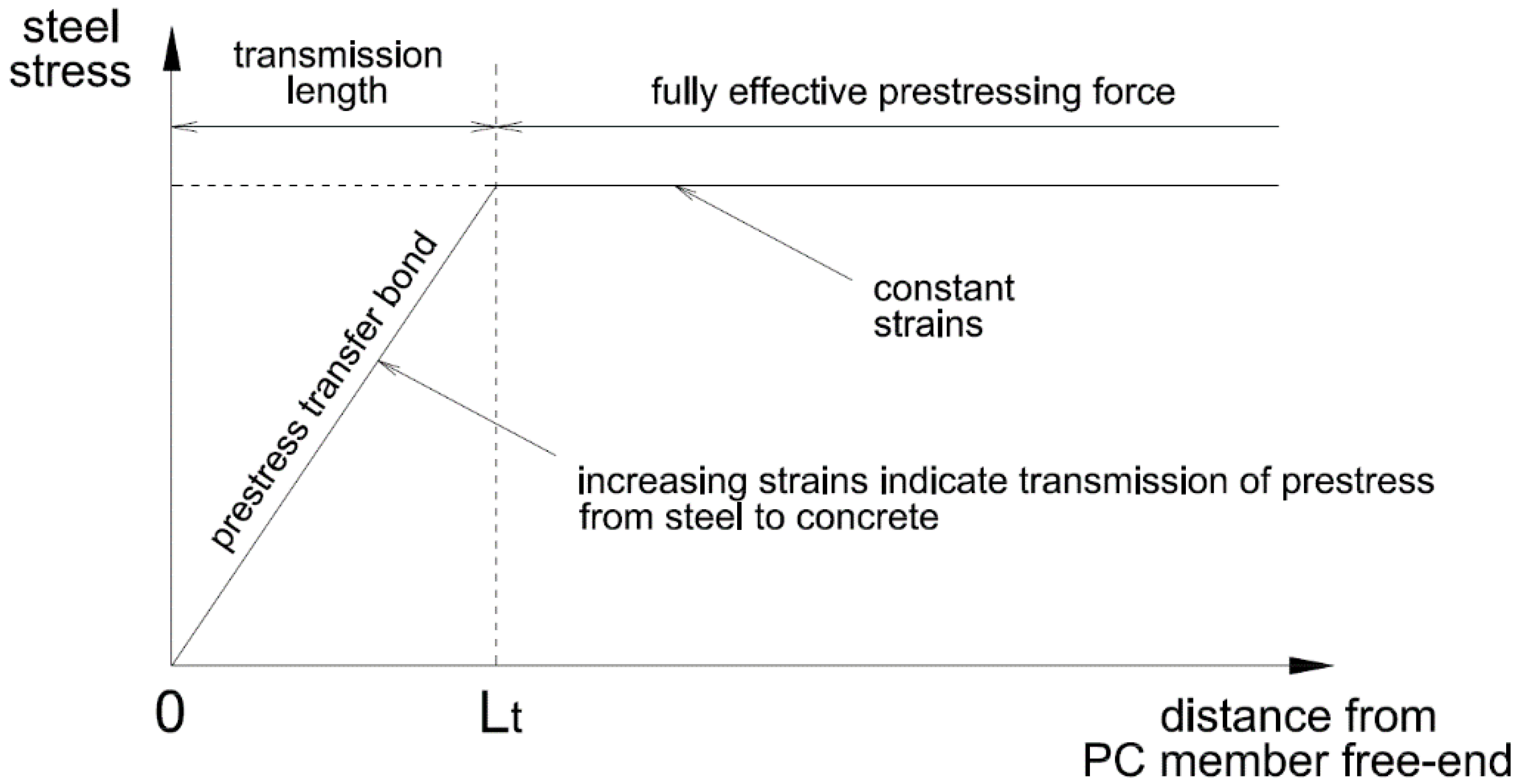





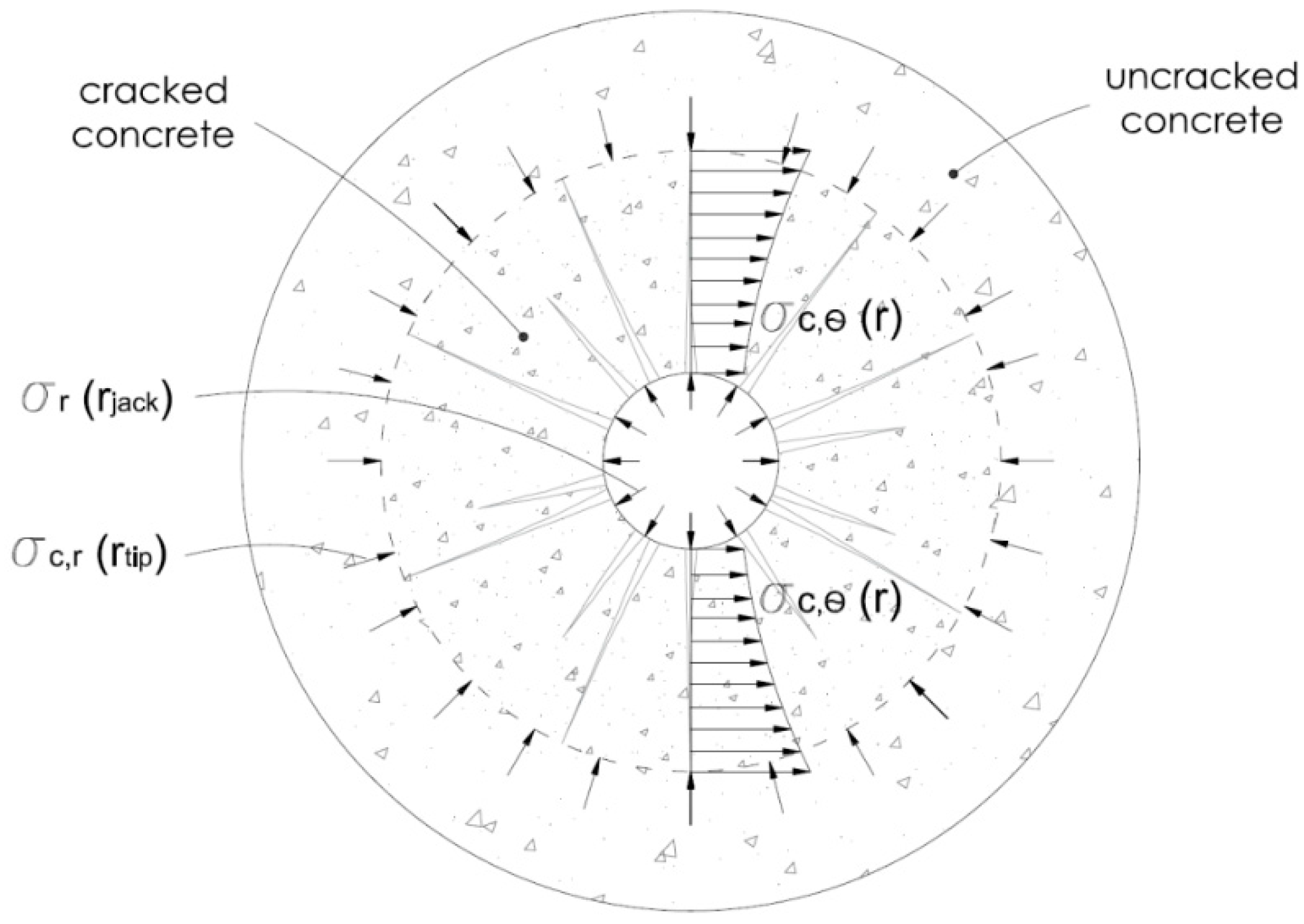
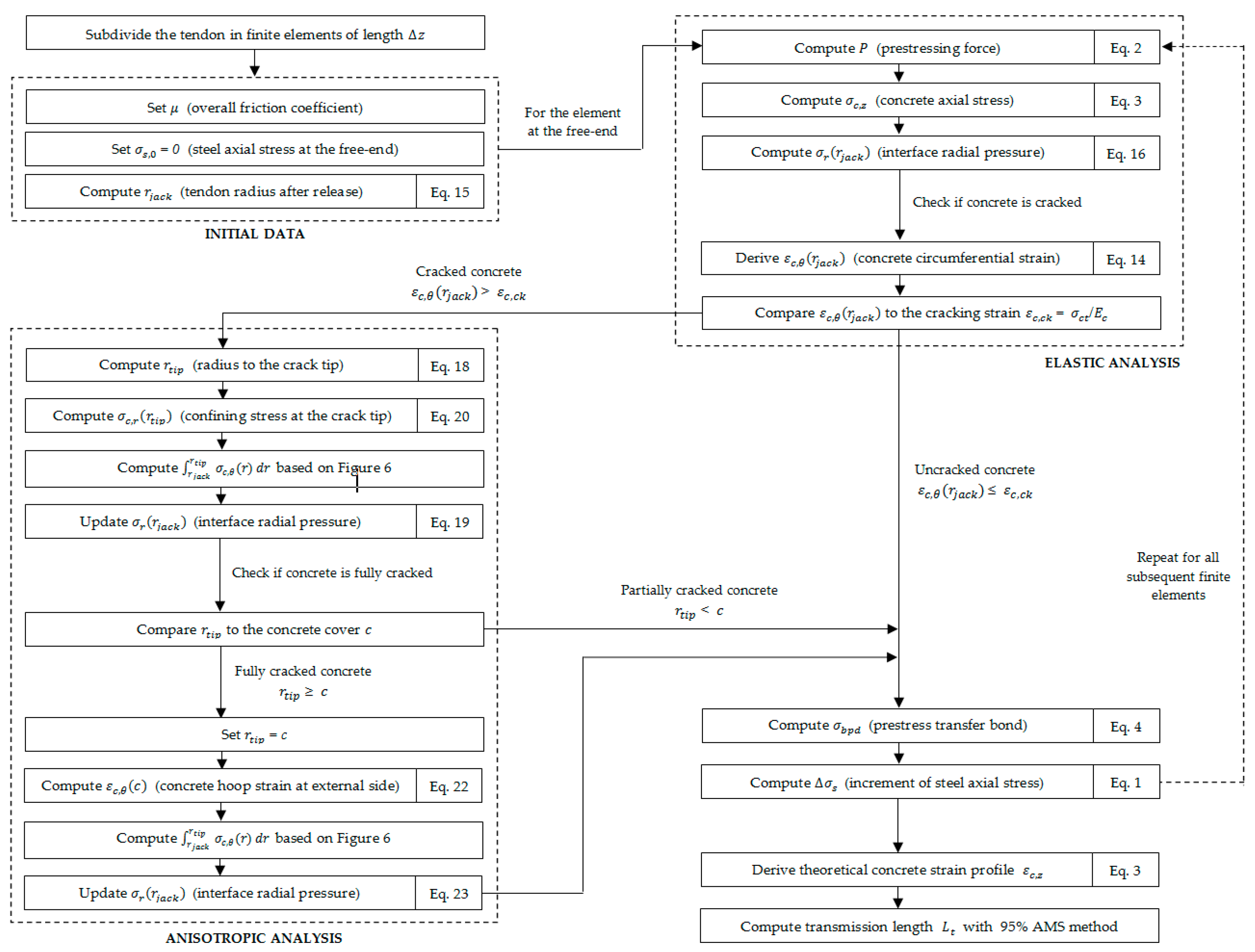
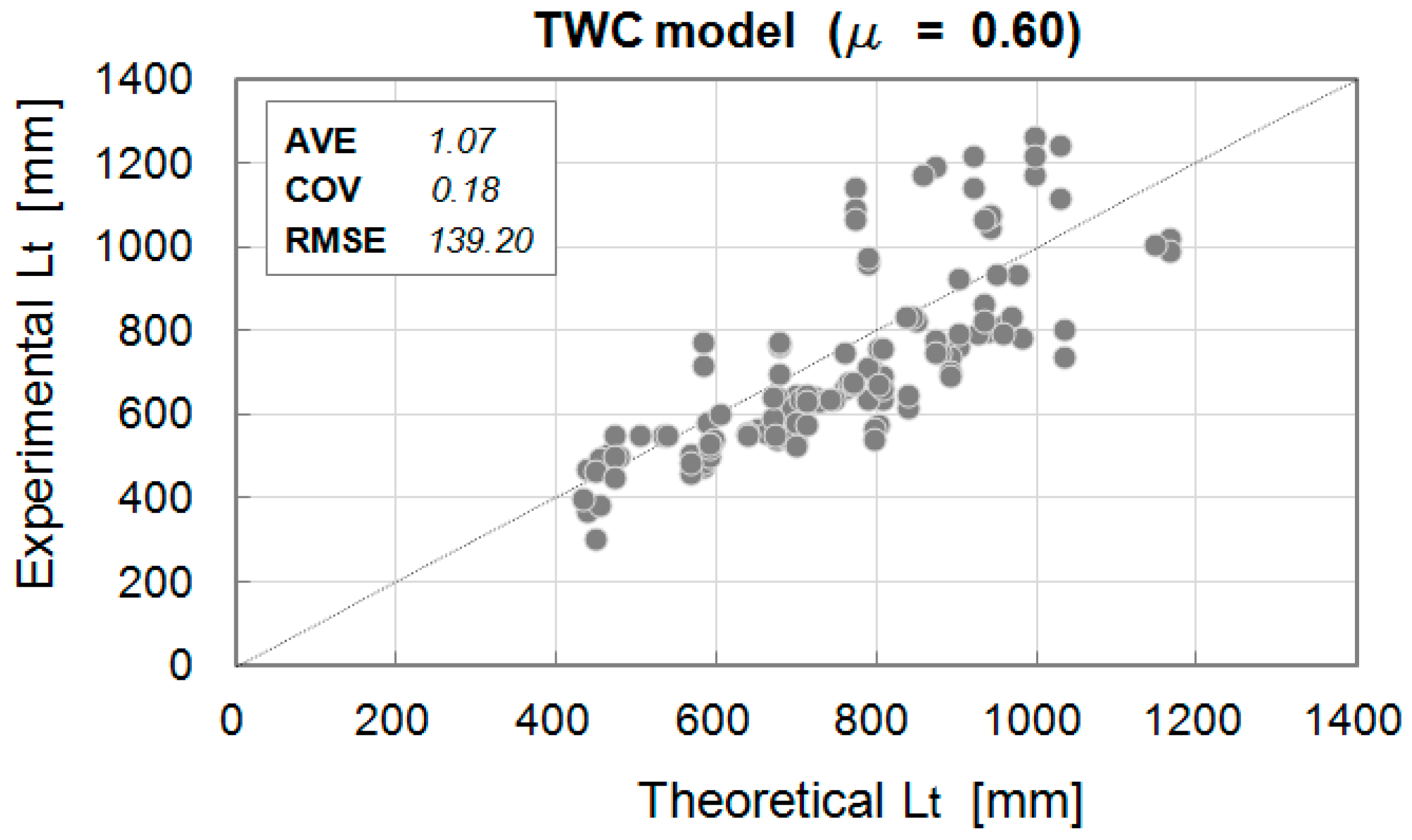


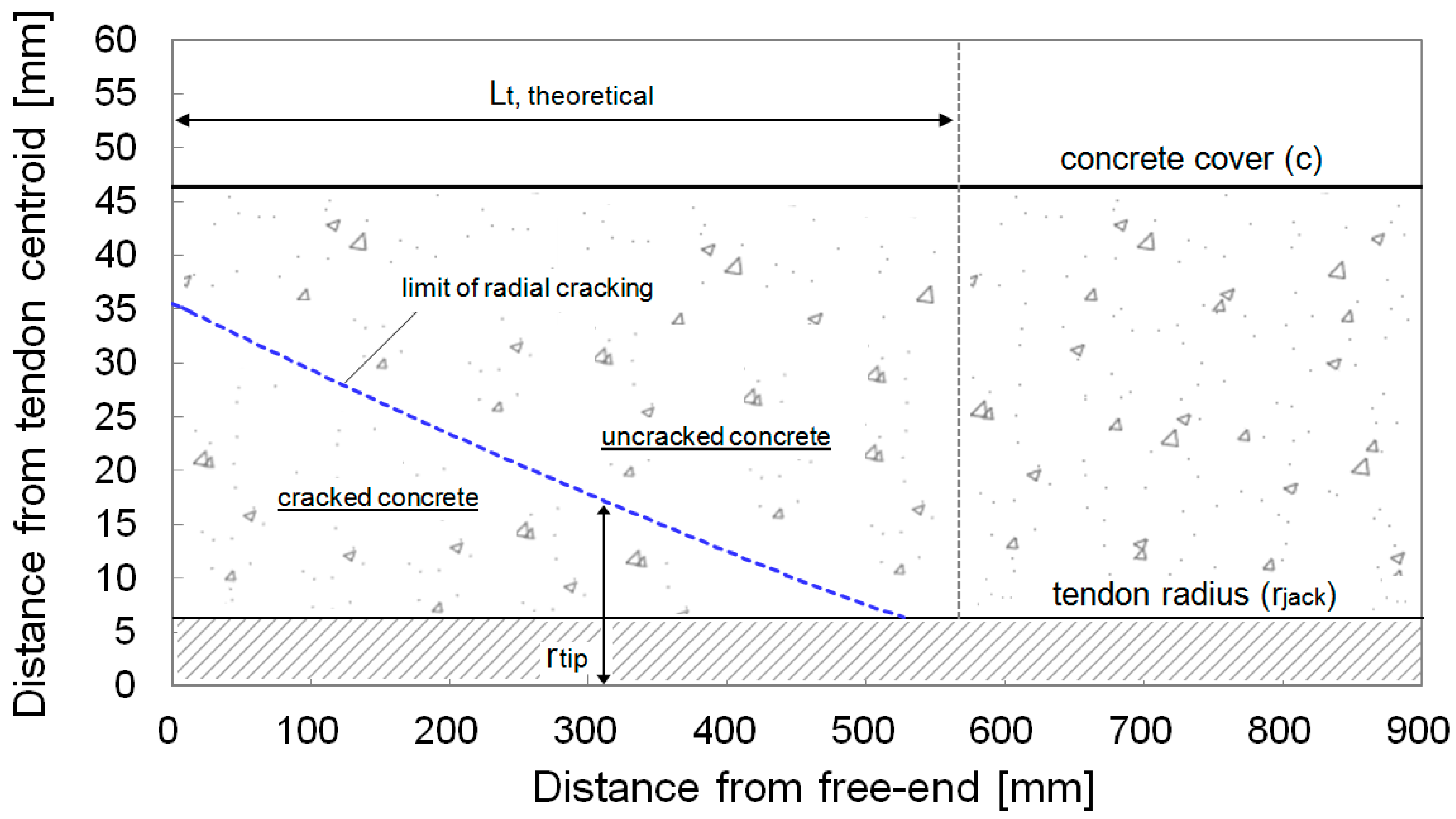
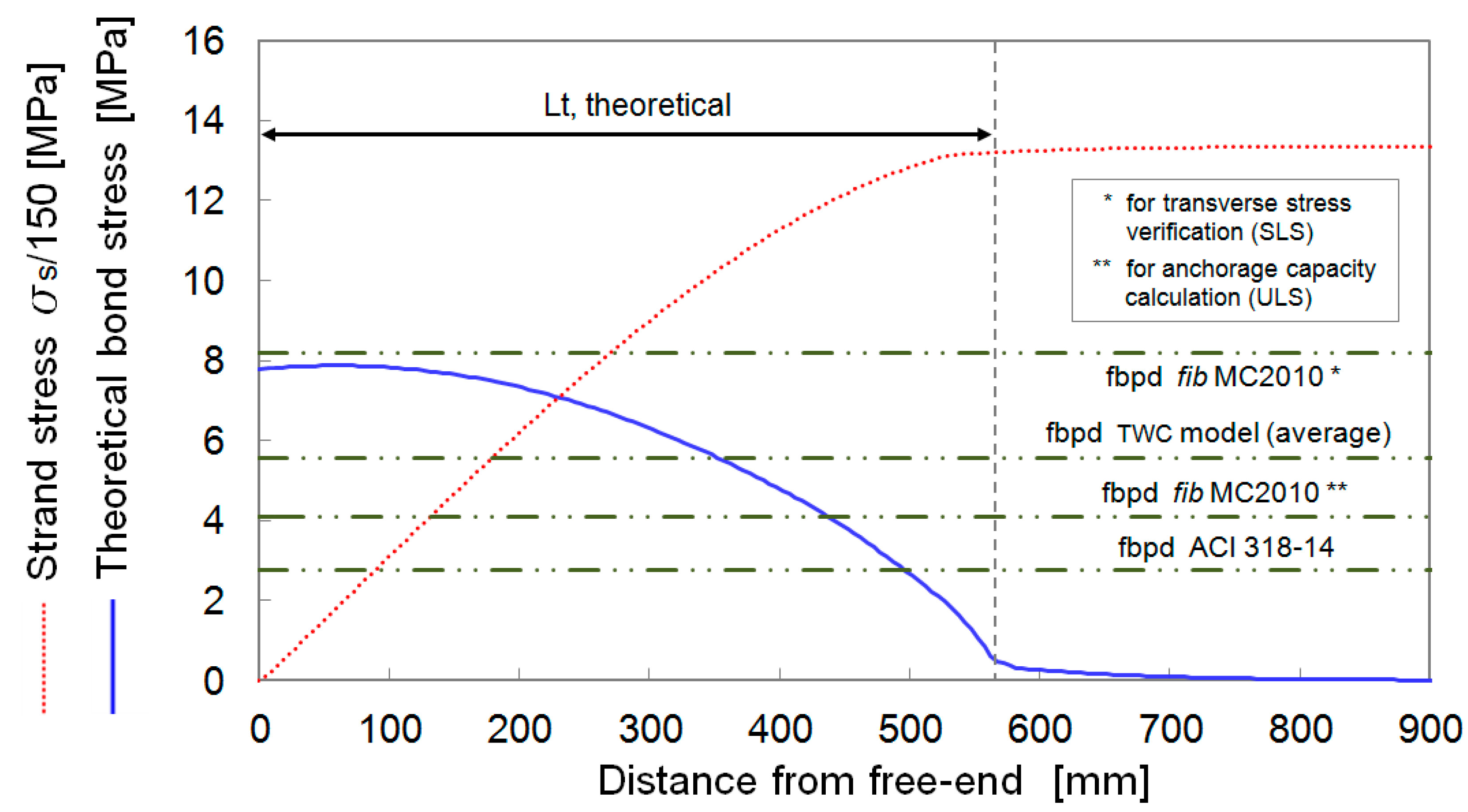
| Reference Citation | No. of Experimental Tests |
|---|---|
| Mitchell et al. (1993) [15] | 14 |
| Russell and Burns (1996) [24] | 20 |
| Russell and Burns (1997) [28] | 12 |
| Oh and Kim (2000) [11] | 36 |
| Oh et al. (2006) [16] | 24 |
| Martì-Vargas et al. (2007) [29] | 12 |
| Dang et al. (2017) [30] | 12 |
| Friction Coefficient | AVE | COV | RMSE |
|---|---|---|---|
| = 0.3 | 2.10 | 1.15 | 755.57 |
| = 0.4 | 1.62 | 0.67 | 439.31 |
| = 0.5 | 1.30 | 0.36 | 232.72 |
| = 0.6 | 1.07 | 0.18 | 139.20 |
| = 0.7 | 0.92 | 0.16 | 154.16 |
| = 0.8 | 0.81 | 0.23 | 207.22 |
© 2020 by the authors. Licensee MDPI, Basel, Switzerland. This article is an open access article distributed under the terms and conditions of the Creative Commons Attribution (CC BY) license (http://creativecommons.org/licenses/by/4.0/).
Share and Cite
Fabris, N.; Faleschini, F.; Pellegrino, C. Bond Modelling for the Assessment of Transmission Length in Prestressed-Concrete Members. CivilEng 2020, 1, 75-92. https://doi.org/10.3390/civileng1020006
Fabris N, Faleschini F, Pellegrino C. Bond Modelling for the Assessment of Transmission Length in Prestressed-Concrete Members. CivilEng. 2020; 1(2):75-92. https://doi.org/10.3390/civileng1020006
Chicago/Turabian StyleFabris, Nicola, Flora Faleschini, and Carlo Pellegrino. 2020. "Bond Modelling for the Assessment of Transmission Length in Prestressed-Concrete Members" CivilEng 1, no. 2: 75-92. https://doi.org/10.3390/civileng1020006
APA StyleFabris, N., Faleschini, F., & Pellegrino, C. (2020). Bond Modelling for the Assessment of Transmission Length in Prestressed-Concrete Members. CivilEng, 1(2), 75-92. https://doi.org/10.3390/civileng1020006





